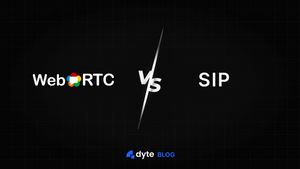In an era of pivotal digital communication, technologies facilitating real-time interaction have gained significant traction. Two of these technologies stand out for their unique capabilities and extensive use: WebRTC and SIP. Both are powerful tools in their own right, with diverse functionalities, advantages, and constraints.
In this article, we dive deep into a comprehensive understanding of WebRTC and SIP, drawing comparisons to help you determine which solution aligns best with your specific communication needs. Let's delve into the world of real-time digital communication to explore these two intriguing technologies.
Understanding WebRTC
WebRTC, short for Web Real-Time Communication, is an open-source initiative that equips browsers and mobile applications with real-time communication features through straightforward APIs. It enables the transmission of video, voice, and generic data between peers, empowering developers to create potent voice and video communication solutions. WebRTC shines in its cost efficiency, broad compatibility with contemporary browsers, and independence from plugins or additional software. On the flip side, it's worth noting that WebRTC does have drawbacks, including possible security vulnerabilities and inconsistent performance on different networks. And that's why there are Managed WebRTCs.
Take a deep dive into WebRTC vs. Managed WebRTC to solve for WebRTCs limitations.
Understanding SIP (Session Initiation Protocol)
SIP, or Session Initiation Protocol, is a signaling protocol for initiating, maintaining, modifying, and terminating real-time sessions that involve video, voice, messaging, and other communications applications & services between two or more endpoints on IP networks. SIP offers robustness, flexibility, and interoperability with existing telephony systems. However, its complexity and the need for additional hardware can be seen as limitations.
When to use WebRTC vs SIP
The choice between WebRTC and SIP depends on your unique communication needs, the resources at your disposal, and your long-term goals. Here's a general guideline on when to use each:
Use WebRTC when:
- Cost Effectiveness is Important: WebRTC is an open-source technology, which means it's free to use. Its independence from plugins or additional software can result in cost savings. But again, it might not have a lot of levies when it comes to customizations.
- Real-Time Peer-to-Peer Communication: For applications that require straightforward, low-latency, peer-to-peer video or audio communication—like video conferencing tools, live streaming platforms, or multiplayer online games—WebRTC is a good fit.
Use SIP when:
- Integration with Traditional Telephony Systems: SIP works well with existing telephony systems, making it suitable for businesses aiming to integrate VoIP with their traditional phone system.
- A Robust and Flexible Solution is Needed: If your project requires a communication protocol capable of handling a wide range of media types—not just audio and video, but also other types of media and instant messaging—SIP's versatility could be beneficial.
Remember, these are general guidelines. The best choice will always depend on your specific circumstances and requirements. Always consider consulting with a communication technology expert before making a final decision.
WebRTC vs SIP: Detailed comparison
| WebRTC | SIP | |
| Definition | An open-source project providing web browsers and mobile applications with real-time communication via simple APIs. | A signaling protocol is used for controlling communication sessions such as voice and video calls over IP. |
| Ease of Use | Simple to use and implement due to browser-based nature and straightforward APIs. | Can be complex to set up and manage due to its robust features and flexibility. |
| Cost | Typically more cost-effective as it is an open-source technology that does not require additional plugins or software. | Can be more costly due to the need for specialized hardware, software, and expertise. |
| Security | Relies on the security of the underlying browser, which could be a potential vulnerability. | Has established security protocols, but interoperability issues can potentially create vulnerabilities. |
| Integration with Other Systems | May have compatibility issues with non-web based systems. | Works well with existing telephony systems and other SIP-based devices. |
| Media Handling | Supports peer-to-peer video, audio, and data communication. | Does not inherently include media streaming; needs to be used with other protocols like RTP. |
| Call Control Features | Lacks built-in call control features; additional development is required for functionalities like call forwarding, transferring, etc. | Comes with robust call control features due to its long history and wide usage in enterprise-level systems. |
Integration of WebRTC and SIP
Interestingly, WebRTC and SIP don't have to be mutually exclusive. They can be integrated, with WebRTC handling the media transmission and SIP handling the signaling. This allows for the benefits of both technologies to be leveraged.
However, such integration does come with its own set of challenges, including potential compatibility issues and increased complexity. That's when platforms like Dyte stand out; you can leverage the power of WebRTC and the capabilities of SIP Interconnect. Integrate real-time video in your app in minutes and save money with managed WebRTC. Get started with 10K free credits with Dyte.
Conclusion
WebRTC and SIP are two different protocols that support different use cases. WebRTC is designed to provide real-time communication capabilities to web browsers and mobile applications. Whereas SIP is a signaling protocol used to control multimedia communication sessions such as voice and video calls over Internet Protocol (IP).
Whether you are deciding to integrate WebRTC v/s SIP or both, you will need both technical expertise and bandwidth to make the most, and that's where you can optimize with Dyte's Video SDKs.
Let us help you get started. If you're curious about what Dyte is capable of, here are some resources to start off your research:
Interested? Let's talk and figure out what Dyte can do to make the development of your video app smoother.
FAQs
Is WebRTC better than SIP?
It depends on the specific use case. WebRTC is generally easier to use and more cost-effective, but SIP offers more robustness and flexibility.
Can WebRTC and SIP work together?
Yes, it's possible to integrate WebRTC and SIP so that they complement each other's functionalities. However, this integration can add to the complexity of the system.



